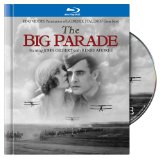| Reviews & Columns |
|
Reviews DVD TV on DVD Blu-ray 4K UHD International DVDs In Theaters Reviews by Studio Video Games Features Collector Series DVDs Easter Egg Database Interviews DVD Talk Radio Feature Articles Columns Anime Talk DVD Savant Horror DVDs The M.O.D. Squad Art House HD Talk Silent DVD
|
DVD Talk Forum |
|
|
| Resources |
|
DVD Price Search Customer Service #'s RCE Info Links |
|
Columns
|
|
|
Big Parade, The
Warner Bros. // Unrated // October 1, 2013
List Price: $27.98 [Buy now and save at Amazon]
The Movie:
King Vidor's The Big Parade is one of the successful and influential movies from the silent era and it's astounding that it took over a decade and a half to release the film on DVD. Good things come to those who wait as Warner Brothers has finally rectified that situation with a pristine looking Blu-ray (also available on DVD) that has a couple of exciting extras. The long neglected classic is finally getting its due.
In 1917 America things seem peaceful and carefree, with no evidence that a horrible war is raging in Europe. After all, that's on the other side of the globe. It doesn't concern Slim (Karl Dane) who works building skyscrapers or Bull (Tom O'Brien) who tends bar. It worries Jim, the idle son of a wealthy tycoon, the least of all. Why should he be bothered by something like a war? That all changes when the US enters the fray. Slim and Bull sign up to do their part, but Jim isn't planning on doing anything like that... it resembles work too much. While driving to the club one afternoon however, he sees a parade of new enlistees and among them are four of his buddies. The shout at him to sign up with them, and between the cheering of the crowd and the patriotic music that sets his toe tapping he can't resist.
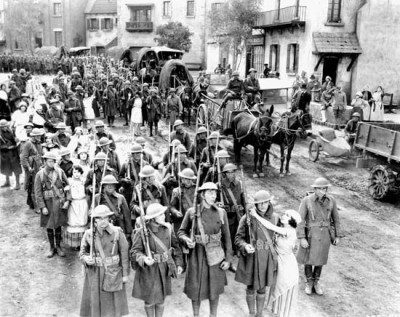
Jim's mother is scared, but his girl is proud of him and so is his father. With a tearful farewell he heads off to basic training, where he meets Slim and Bull, and gets some rudimentary instructions. After that it's off to France where his company gets stationed in a small town and told to wait. Jim and his buddies are assigned a loft in a barn to sleep and they spend their days just cooling their heels. It's here that Jim meets Melisande, the daughter in the family that owns the farm where he's stationed. He doesn't speak French, and she doesn't speak English, but they somehow are able to communicate and end up falling in love. Things are looking good until they get their orders and Jim, Slim, and Bull along with the rest of their battalion are sent to the front lines.
This is one of those movies that work on multiple fronts. The story is carefully constructed and unfolds in such a fashion to give the last half a real punch. The beginning of the movie is pretty light, which is surprising for a war film. There are even a couple of very humorous scenes, such as when Jim's girl from back home sends him a cake that she baked herself. It turns out to be so hard that his bayonet won't cut it. Another funny sequence has Jim trying to get a barrel back to his camp and rolling it though the streets. They're covered with mud and it's very slow going, so he puts the barrel over his head and walks back, awkwardly, peering though a hole in the side. Of course Melisande sees him making a fool of himself and can't help but make things even more difficult for him.
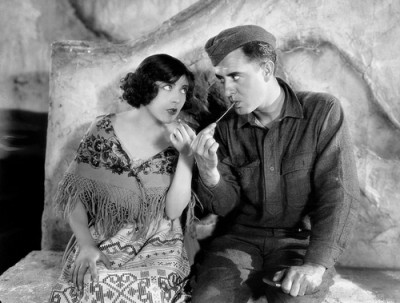
The tone changes dramatically when they get sent off to the front. The scene where they depart is particularly touching. Jim is bummed that he's going to have to leave Melisande, but she, on the other hand, is frantic and distraught. After all, she has first hand knowledge of what happens to people who find themselves in the trenches. As the truck carrying Jim and his friends pulls out she grabs onto a chain welded to the side and runs along as long as she can, crying the whole time.
Much later, the group arrives at the theater of combat. They're near a forest that has German snipers and machine guns scattered throughout. The order is given to fix bayonets and the men march into the forest. It's a powerful scene that the director, King Vidor, filmed by having kettle drums pound out a beat. The men are all moving at the same time and speed, scattered between the trees when one just falls over. Then another one. It takes a few deaths before they even realize they're under attack. They men continue to walk in a slow, deliberate pace while shooting back and dropping. The staging is beautiful and makes the contents of the scene all the more powerful because of it.
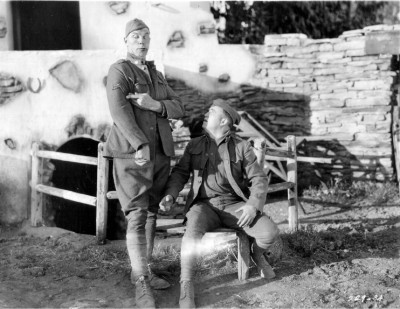
This movie is removed from other war films of the time and earlier because it gives a realistic and human face to war. The American soldier's aren't skillful warriors who win the day but regular people thrust into a situation that's way beyond their control. Conversely the Germans aren't cruel villains who throw babies out of windows (as Erich von Stroheim did portraying a German officer in 1918's The Heart of Humanity) but just ordinary people doing what they've been told to do. In one scene Jim pursues a German who had just shot him into a bomb blast crater. Jim is going to stab him in the throat with a knife until he see that his opponent is a very young man, who is just as scared as he is. By showing both the brutality of war as well as the human face of the enemy, Vidor made this a very effective anti-war film.
The acting is also superb. John Gilbert was already a star, but this film cemented his reputation (at least for a while... once sound arrived Gilbert's career waned for several reasons) and it's easy to see why. The good looking Gilbert easily played the dashing rich playboy, but he also did a great job making that character sympathetic once he was overseas. He turned Jim from an entitled lay-about into a regular fellow seamlessly. The other real star of the film is Renee Adoree who played Melisande. She's spunky and loyal and made it seem believable that her character would fall for the charming yank.
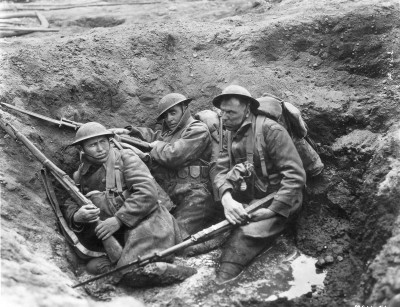
The Blu-ray:
This single Blu-ray disc arrives in a nice digi-book package. See the Extras section for more information.
Video:
The AVC 1080p image is quite impressive. The film was restored in 4K from the recelently rediscovered original camera negatives (which were thought to have been destroyed in a fire for years) and the results are spectacular. If it was a recent film it would look fine, but taking into account that the movie is 88 years old makes the picture quality astounding. It's a crisp, clean presentation with virtually no print damage aside from a couple of missing frames (and I only noticed that twice). Viewers will be very pleased with the level of detail which allows the fine lines on John Gilbert's suit to be distinguished, to note just one example. The blacks are deep and inky and the contrast is excellent. This is a truly wonderful presentation of an important silent film.
Audio:
The DTS-HD MA stereo soundtrack features a score written by Carl Davis in 1988 and performed by the 45-piece English Chamber Orchestra and it sounds just as good as the image looks. The score itself is excellent with Davis drawing upon popular tunes of the time (You're in the Army Now, Over There) to set the time of the piece. The music accents the action on screen wonderfully and sets the mood. The minimalist approach he took for the march through the forest, where German snipers and machine guns start picking off the American soldiers, works beautifully. The score sounds great on the disc too, with a wide range and deep sound. I really can't complain.
Extras:
There are only a few extras included on the disc, but they are high quality bonuses that really make this a complete package. I'd much rather have 2 or 3 solid extras than a dozen fluff pieces.
It starts off with a commentary track by film historian Jeffrey Vance. I've always enjoyed Vance's commentaries and this is no exception. It's very comprehensive and covers all facets of the films creation as well as discussing the careers of the actors and crew. What really makes this a memorable track is that Vance includes archival (audio) interviews King Vidor, discusses the film. A truly wonderful track that's educational and entertaining.
The video extras are limited to a theatrical trailer and a very interesting short: a tour of the MGM studios from 1925. This in an in depth look at the film factory, running 32-minutes in length. The camera goes to all of the various departments and shows what it takes to make a silent film. This doesn't seem to be something that was intended for theatrical release; it's doubtful that audiences of the day would sit for half an hour watching a short that's rather dry at times. Maybe it was something that was shown to potential investors back in New York. In any case I'm glad it still survives. Seeing it today is like looking through a window to the past.
Finally there's the digibook itself. I really enjoy this type of packaging, and The Big Parade includes one of the most impressive book sections that I've run across. The 64-page book includes some thorough comments on the film and King Vidor from historian and silent film champion Kevin Brownlow, a reproduction of the original program book, and some wonderful stills and behind-the-scenes shots. An excellent package all around.
Final Thoughts:
One of the great American films about WWI from the silent age, The Big Parade, is finally available on DVD and Blu-ray. For those of you who have been waiting, you'll be pleased with the results. The 4K restoration looks beautiful and the bonus material is great. This landmark film arrives as one a the more impressive discs of the year. DVD Talk Collector's Series.
|
| Popular Reviews |
| Sponsored Links |
|
|
| Sponsored Links |
|
|
| Release List | Reviews | Shop | Newsletter | Forum | DVD Giveaways | Blu-Ray | Advertise |
|
Copyright 2024 DVDTalk.com All Rights Reserved. Legal Info, Privacy Policy, Terms of Use,
Manage Preferences,
Your Privacy Choices | |||||||









